
Allocasuarina, commonly known as sheoak or she-oak, is a genus of flowering plants in the family Casuarinaceae and is endemic to Australia. Plants in the genus Allocasuarina are trees or shrubs with soft, pendulous, green branchlets, the leaves reduced to scale-like teeth. Allocasuarinas are either monoecious or dioecious, the flowers never bisexual. Male and female flowers are arranged in spikes, the female spikes developing into cone-like structures enclosing winged seeds.

Allocasuarina fraseriana, commonly known as western sheoak, common sheoak, WA sheoak. Fraser's sheoak or just sheoak, is a tree in the family Casuarinaceae. Endemic to Western Australia, it occurs near the coast in the south west corner of the State, from Jurien to Albany . The Noongar peoples know the tree as kondil.condil, kulli or gulli.

Allocasuarina huegeliana, commonly known as rock sheoak or sighing sheoak, is a tree in the family Casuarinaceae. Endemic to Western Australia, it occurs mostly throughout the Wheatbelt region. It is now especially common on road verges, where it sometimes forms thickets.
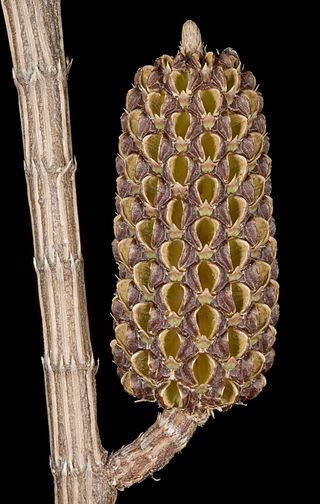
Allocasuarina lehmanniana, commonly known as dune sheoak, is a shrub in the family Casuarinaceae. Endemic to Western Australia, it is widespread along on the coast from the Murchison River south to Israelite Bay.

Allocasuarina humilis, commonly known as the dwarf sheoak or dwarf casuarina, is a woody shrub of the family Casuarinaceae endemic to the south-west of Western Australia.

Allocasuarina distyla, commonly known as scrub she-oak, is a shrub or small tree of the She-oak family Casuarinaceae endemic to New South Wales.

Allocasuarina verticillata, commonly known as drooping she-oak or drooping sheoak, is a nitrogen fixing native tree of southeastern Australia.
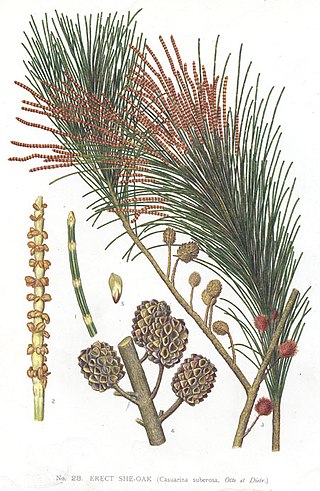
Allocasuarina littoralis, commonly known as black sheoak, black she-oak, or river black-oak, is an endemic medium-sized Australian tree. A. littoralis is named for its growth near the coast; this is somewhat misleading, as it will grow well both inland and in coastal zones. Studies have shown that in long-time unburnt coastal woodlands, A. littoralis has replaced the original Eucalyptus-dominated woodland.

Allocasuarina portuensis, commonly known as the Nielsen Park she-oak, is an extremely rare plant growing in Sydney, Australia. Encountered as a shrub or small slender tree, up to 5 metres tall, it has green drooping branchlets up to 27 cm (10.5 in) in length. It is dioecious, that is, male and female flowers are borne on separate plants. Measuring 1.2–1.5 cm (0.47–0.59 in) long and 0.8–1 cm wide, the cones are perched on 0.2–1.5 cm long peduncles arising from the branchlets.
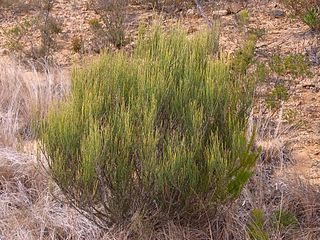
Allocasuarina nana, commonly known as the dwarf she-oak, is a small, usually dioecious plant found in eastern Australia. Often seen around one metre tall, it grows in exposed heathlands, ridges, clifftops on sandstone based soils. It is found on the coast and tablelands, south of the Cudgegong River near Mudgee.

Allocasuarina inophloia, also known as woolly oak, or stringybark she-oak, is a shrub or small tree of the she-oak family Casuarinaceae endemic to inland New South Wales and Queensland. The hairy bark is an unusual feature.

Allocasuarina grampiana, commonly known as Grampians sheoak, is a dioecious shrub or tree of the family Casuarinaceae. The species is endemic to the Grampians in Victoria, Australia where it grows on sandstone outcrops. It grows to between 1 and 4 metres high and has ascending needle-like branchlets to 15 cm long which have a waxy bloom. Cones are cylindrical and are between 13 and 35 mm long and about 8mm in diameter. These produce 5mm long winged seeds.

Allocasuarina decussata, commonly known as karri oak or karri she-oak, is a medium-sized tree, or more rarely a shrub, that is endemic to the south west of Western Australia. It is an understory tree in karri forest but also occurs as a stunted shrub in places like Bluff Knoll in the Stirling Range.
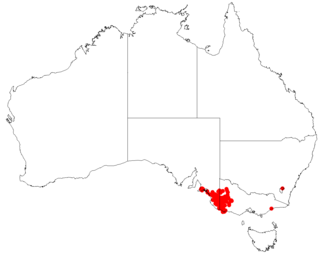
Allocasuarina mackliniana is a shrub of the genus Allocasuarina native to the western Victoria.
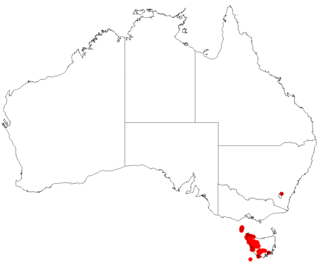
Allocasuarina zephyrea, commonly known as the western sheoak or western scrub sheoak, is a shrub of the genus Allocasuarina native to Tasmania. It is a common and widespread shrub occurring in Central and Western Tasmania.
Allocasuarina emuina, commonly known as the Emu Mountain sheoak, is a shrub of the genus Allocasuarina native to Queensland.
Allocasuarina filidens, commonly known as the Mount Beerwah sheoak, is a shrub of the genus Allocasuarina native to Queensland.

Allocasuarina misera, commonly known as the small sheoak or the slender sheoak, is a species of the Allocasuarina genu native to Australia.

Allocasuarina pusilla, commonly known as the heath oak-bush or the dwarf she-oak, is a species of Allocasuarina genera native to Australia.
Allocasuarina hystricosa is a species of plant in the sheoak family Casuarinaceae that is endemic to south-western Western Australia.


















